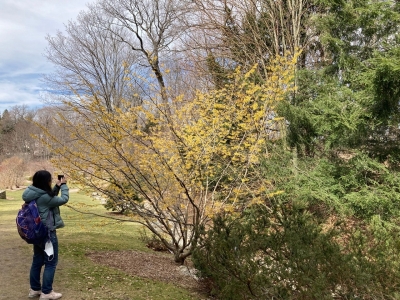Environmental History Conference Brings Interdisciplinary Eye to Human Development
by Stephanie M. McPherson
Environmental history helps experts analyze the present climate crisis in the context of the past. Decisions that brought us to this moment—from converting forests to farmland centuries ago to the advent of power plants—provide insights on how to better arm ourselves in the fight against climate change. Collaboration with this interdisciplinary group of scholars can help the Schiller Institute make progress in their work on energy and the environment.
To that end, Schiller co-sponsored the 2023 American Society of Environmental History conference, which was hosted in Boston March 22 through 26.
“A key goal of the Schiller Institute is to help develop collaborations amongst scholars of all disciplines,” says Dr. Laura J. Steinberg, Seidner Family Executive Director for the Schiller Institute and a speaker at an opening session of the conference. “We hope that the folks in the room will consider working with the Institute as we engage locally, nationally, and globally to address some of the most important environmental problems that we face.”
Environmental history studies the human-influenced changes that have occurred throughout the world’s natural landscapes and how those changes affect both the Earth and humanity itself. The conference brought together more than 600 experts in the field, from academic historians to leaders of local Native American tribes. Four days of seminars, talks, and field trips gave scholars the opportunity to expand their points of view and strengthen their research ideas. Because the environmental history specialty is so broad with so many areas of focus, it is an inherently interdisciplinary field.
“Many environmental historians have backgrounds in the sciences or as park rangers or public historians or K to 12 educators,” says Conevery Valencius, Professor of History and a co-organizer of this year's conference. “I worked with UMass Boston on a tour of Boston Harbor that involved both the Boston City archeologist, the sachem of the Massachusetts tribe, and the acting dean of the School for the Environment at UMass Boston to say, ‘how are we finding out about the past of the Boston region in conversation with indigenous peoples in ways that connect the social sciences with humanities and the physical sciences?”
A separate field trip to the Arnold Arboretum showed attendees the biodiversity that has been preserved in the middle of Boston’s urban landscape. The trip also attracted a wide variety of experts.
“We had staff members from the U.S. Fish and Wildlife Service, alongside a curator of rare manuscripts, alongside various history faculty, early career faculty, and even a non-traditional graduate student with an extensive background in dairy farming,” says Laura Clerx, a PhD candidate in the history department and the leader of the Arnold Arboretum trip. “An interest in the methods and outcomes of environmental history is what brought all of these people together; and I think the conversations that can take place among this sort of group and in these settings is the most valuable thing that attendees take away from the conference.”
The work done by environmental historians of all stripes helps researchers take a long view of the course from an untouched natural world to a planet covered in houses, roads, factories, dams, mines, and so much more.
“The big issues of our present—climate change, deforestation, loss of biodiversity—how have human communities adapted to these things in the past? Anything we can learn from that?” says Clerx. “Untangling the historical threads of how we got here in terms of our reliance on fossil fuels and this economic structure that has brought us to the present climate challenges. Is there some way in which by untangling those historical threads we can see a way to move forward?”
The field also recognizes that there is a place for human development—but the key to solving the problems facing the world is to find a way to work in harmony with the natural resources we have left.
“Myself, as a person with an undergraduate degree in civil engineering and a PhD in environmental engineering, I can see the push and pull of the desire to create structures and facilities to aid communities and the very real concerns about environmental destruction that can occur from that,” says Steinberg.
This is the type of work Schiller hopes to support as they continue to develop their presence within Boston College and in the environmental research world beyond campus.
“I’m really excited that both the Schiller institute and the Morrissey College of Arts and Sciences, both of whom helped substantially support this conference, are seeing what I see,” says Valencius. “They are both correctly perceiving the ways in which this scholarly organization is trying to live out the Boston College goals of furthering excellent research, but for the common good.”



